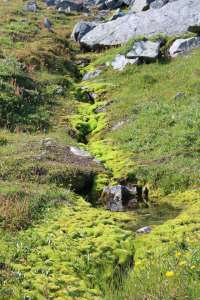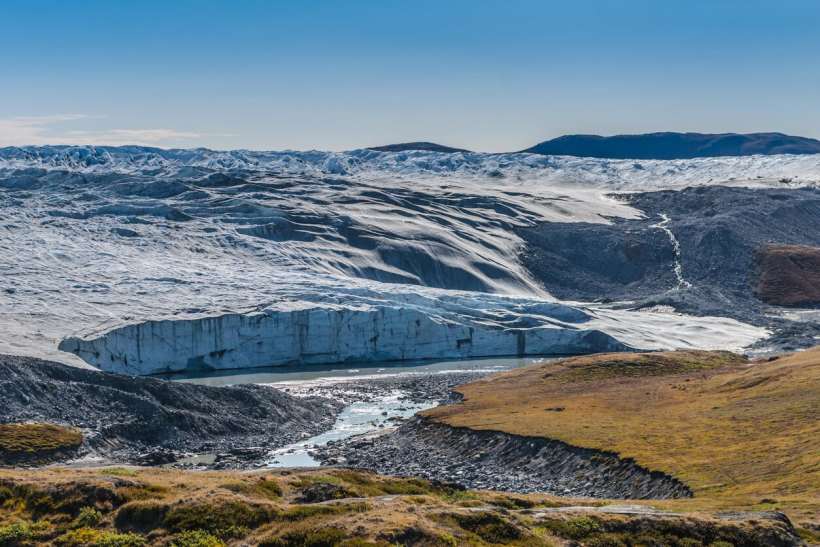A recent study published in Scientific Reports showed significant changes in Greenland. More specifically, changes in the country’s ice-covered landscape in the past three decades.
The area of ice loss in those years is similar to 36 times the size of New York City.
As ice fades away, wetlands and shrubs have grown unexpectedly fast.
For this study, the researchers analyzed satellite imagery. They found a doubling of vegetation between the mid-1980s and mid-2010s.
Areas and places which were once covered in ice and snow have changed. They have transformed into barren rock, wetlands, or shrub zones, with wetlands alone quadrupling during this time.

According to the researchers, there’s a loss of 28,707 square kilometers (around 11,000 square miles) of ice.
This raises concerns about its broader impacts on climate change and sea level rise.
As we know, warmer air temperatures lead to ice loss. In turn, it makes land temperatures rise and melts permafrost–a frozen layer beneath the Earth’s surface.
When permafrost melts, it releases methane and planet-warming carbon dioxide. Basically, it’s a vicious cycle of global warming.
Other than that, such an ice loss also causes land instability, potentially affecting buildings and infrastructure.
Jonathan Carrivick, one of the report’s authors, emphasizes the cascading effects of ice loss.

“We have seen signs that the loss of ice is triggering other reactions, resulting in further loss of ice and further ‘greening’ of Greenland,” Carrivick said.
The study introduces the concept of a feedback loop. It’s where diminishing ice leads to increased absorption of solar energy in previously reflective areas.
As a result, land surface temperatures rise, causing further ice melt and negative impacts–as mentioned.
Apart from climate concerns, the loss of ice is affecting Greenland’s indigenous communities, as well.
Michael Grimes, the lead author of the report, said the flow of sediments and nutrients into coastal waters was problematic. In particular, it’s problematic for those relying on fishing and hunting.
Indigenous people do a lot of traditional practices, and those rely on stable ecosystems. With this loss of ice, they face critical challenges.

What’s going to happen to Greenland?
Greenland is the world’s largest island. It’s an autonomous country within the Kingdom of Denmark.
It has unfortunately been warming at twice the global mean rate since the 1970s. The people who live there, including the indigenous population, depend heavily on natural ecosystems for survival.
Now, Greenland’s ice sheet holds a significant importance in the battle against climate change.
If it melted entirely, sea levels could surge by as much as seven meters. That’s equivalent to the height of a typical house.
With more vegetation coming up and our current climate situation, one may ask if we could do something about it. “Is there any way to reverse the damage?” The question asks.
Another study published in the journal Nature explores questions like these.

In the study, researchers found that some things are possible.
For instance, the worst-case scenario of ice sheet collapse and subsequent sea-level rise can be avoided. However, it depends on our ability to reduce projected global temperatures post-2100.
Basically, the researchers say, yes we can change the worst-case scenario. But, we have to do it soon and fast.
The sooner we bring down temperatures, the greater the likelihood of reducing ice loss and its impact.
Per this study, Greenland has lost over 300 billion cubic meters of ice sheet per year. It contributes to a yearly sea level rise of almost one millimeter.
As mentioned about the vicious cycle of Greenland’s ice and global warming, the researchers underscores the urgency of capping the temperatures to 1.5°C above pre-industrial levels.

Understanding how the country’s ice sheet will respond to future warming is necessary. So, the researchers used sophisticated computer models to simulate ice motion.
They divided the ice sheet into thousands of 3D segments, factoring in variables like climate change, ice thickness, and temperature.
However, these projections are full of uncertainties, including the complexities of ice movement over bedrock and climatic shifts over millennia.
To tackle such uncertainties, another team of researchers utilized cutting-edge computer programs. Here, they simulated various warming scenarios over tens of thousands of years.
The scenarios include gradual warming trajectories and stabilizing temperatures post-“peak” warming.
They found that there are intricate dynamics of Greenland’s ice sheet.

Greenland ice sheet amidst global warming
According to this study’s model’s prediction, if temperatures peak at 2°C or so, and remain there, it’ll turn bad. Bad, as in substantial ice sheets will collapse after several thousands of years.
Though, as mentioned, if warming is seriously prevented post-2100, things change.
In the models, there’s an inertia in the ice sheet’s response. It means that warming is at least partly reversible as long as temperatures are quickly brought back down.
For instance, if temperatures stabilize by the year 2200 at less than 1.5°C of warming ,the ice sheet should remain smaller than at present, but stable.
In this case, it doesn’t matter how far (but within reason) peak temperatures overshot 1.5°C in the year 2100. In terms of sea rise, it may likely be capped at a meter or so.

But of course, such a recovery becomes impossible if it takes too long to get temperatures down. It’s also improbable if temperatures remain too high.
When that happens, the ice sheet will collapse, and there will be a substantial sea-level rise.
The journal Nature researchers stated that we can avoid the very worst if we keep trying to reduce global temperatures.
And while this study shows optimism and hope, these projections are still subject to substantial uncertainty. Meaning, we still have more work to do.
Speaking of projections, the study authors reiterate that these results are not necessarily specific predictions. Rather, they’re there to provide insight into possible pathways.
Grimes from the Scientific Reports study is in accord with this study. According to the lead author, “The loss of ice mass in Greenland is a substantial contributor to global sea level rise, a trend that poses significant challenges both now and in the future.”

As Greenland is facing challenges with changes like these, the implications are not limited in the ice sheets. There will be broader impacts on the climate and the communities that live on the island.
All of the researchers call for urgent climate action.
Looking from both studies, we now have insights to act in the present and in the future.
Because, we all want a future where the Greenland ice sheet remains a strong force for stabilizing global sea levels.
Sources:
https://edition.cnn.com/2024/02/13/climate/greenland-ice-loss-vegetation-climate-intl/index.html



Leave a Reply